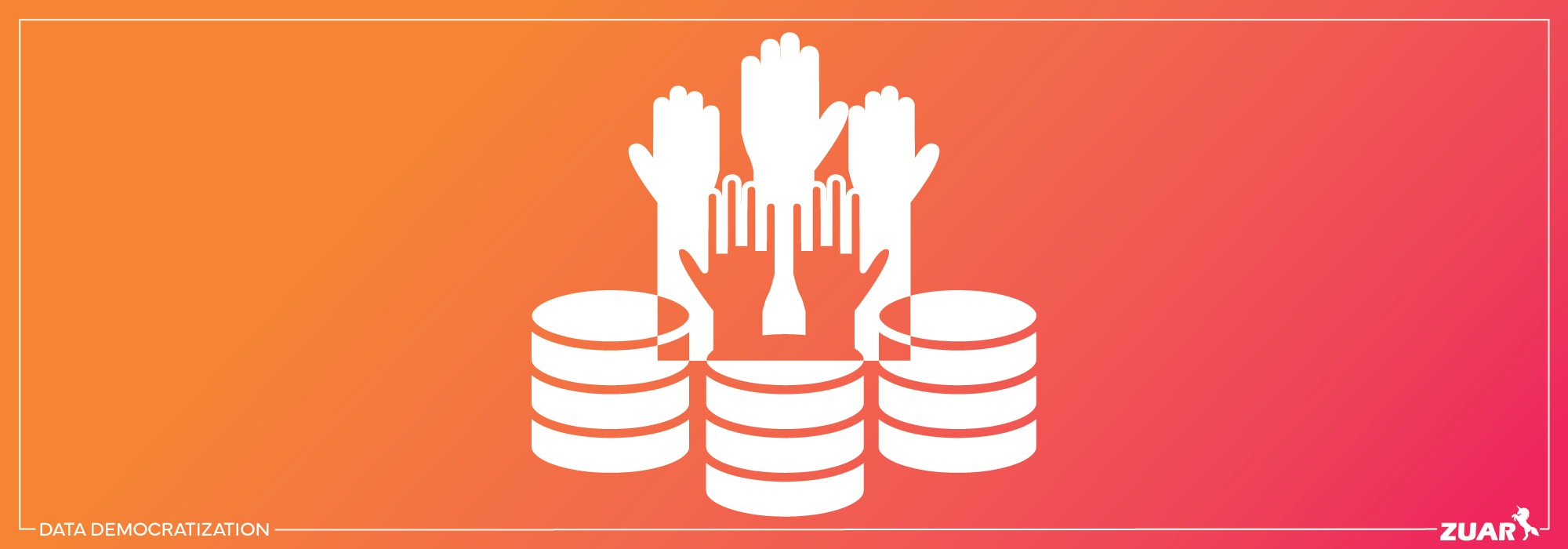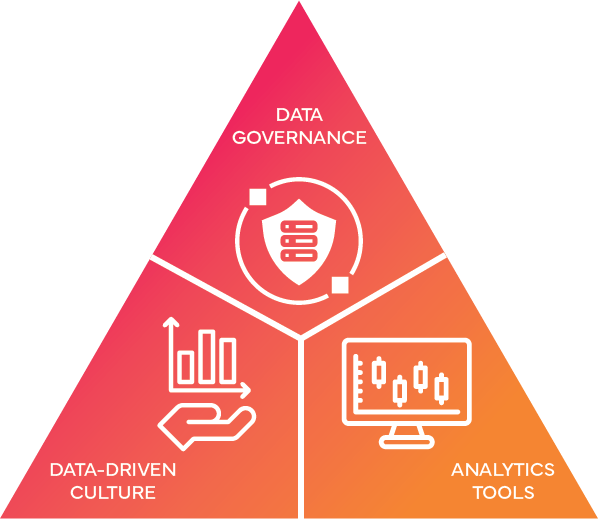The Rise of Data Democratization: Empowering Everyone with Data Access
Learn how you can harness the power of data democratization to empower everyone with easy analytics access.

Overview
In today’s increasingly data-driven world, businesses recognize the immense value of data for making informed decisions and driving innovation. But how can organizations truly unlock the power of data?
The answer lies in data democratization, a powerful approach that empowers individuals within an organization to access and leverage data for better decision-making and innovation.
Key Takeaways
- Data democratization is the process of making organizational data more accessible and understandable to a wider range of stakeholders.
- It requires an effective data governance framework, user-friendly analytics tools, and a data-driven culture in order to provide all individuals with access to pertinent data.
- Measuring success involves key performance indicators (KPIs) and continuous improvement initiatives for sustained success.

Understanding Data Democratization
What is data democratization? This term refers to the process of making data accessible and understandable to a wider range of people within an organization, empowering them to make informed decisions and drive innovation. It involves:
- Streamlining the data stack
- Removing data gatekeepers
- Providing different teams with easy access to the company’s comprehensive data platform through a user-friendly dashboard.
We will now discuss the necessity of data democracy, also known as data democratization, and its essential elements.
The Need for Data Democratization
The growing importance of data-driven decision-making in the business landscape fuels the need for the democratization of data. By breaking down traditional data silos and granting employees access to relevant data, organizations can make faster, more informed decisions.
Furthermore, a robust data architecture facilitates the connection of data platforms with applications, allowing for simplified data access and self-service data consumption.
Data democratization helps in the following ways:
- Dismantling data silos, which have long been a barrier to effective collaboration and decision-making
- Providing employees with easy access to data, enhancing collaboration and innovation
- Unlocking the full potential of data assets
Key Components of Data Democratization
One of the fundamental principles of data democratization is ensuring all individuals have access to pertinent data, which leads to improved decision-making and increased innovation.
To achieve true data democratization, organizations must focus on three key components: data governance, user-friendly analytics tools, and a data-driven culture.

Data governance: This involves establishing and maintaining control over the collection, storage, and utilization of data, with clear policies and procedures in place for data access, usage, and sharing.
User-Friendly Analytics Tools: These tools enable employees to quickly access, analyze, and visualize data, empowering them to make informed decisions and gain insights from data without relying on IT support.
Data-Driven Culture: This fosters an environment in which data is viewed as a valuable resource and is employed to make decisions and promote change.
Watch this video from Zuar's CEO, Whitney Myers, to learn about the three pillars of data democratization:

Overcoming Challenges in Data Democratization
While data democratization offers numerous benefits, it also presents some challenges, such as ensuring data quality and security, as well as addressing the data literacy gap among employees.
We will now discuss these hurdles and the tactics to surmount them.
Data Quality and Security Concerns
Data quality and security are critical concerns in data democratization. Ensuring data quality is essential to guarantee confidence in enterprise data and facilitate higher adoption.
Implementing comprehensive data governance policies can help maintain data quality and address security concerns, as it involves setting clear guidelines for data access, usage, and sharing.
Continuous monitoring is another crucial aspect to mitigate data quality and security concerns. Regular assessments of data quality, coupled with effective data governance practices, can help organizations maintain data integrity and ensure that data is being used responsibly.
Bridging the Data Literacy Gap
Data literacy is an essential element of data democratization, as employees with data literacy skills demonstrate greater performance than those who lack the same fundamental data skills.
To bridge the data literacy gap, organizations must invest in training and support for employees, enabling them to effectively use data in their roles.
Fostering data literacy throughout the organization not only helps employees make better use of data but also encourages a culture of continuous learning and improvement.
By providing company-wide training and educational opportunities, organizations can ensure that employees have the necessary skills and knowledge to make the most of data democratization initiatives.

Implementing a Successful Data Democratization Strategy
A successful data democratization strategy involves:
- Establishing a comprehensive data governance framework
- Investing in user-friendly analytics tools
- Cultivating a data-driven culture within the organization
We will now scrutinize each of these elements in depth.

Establishing a Data Governance Framework
A robust data governance framework is crucial for managing data effectively. By defining roles and responsibilities for data management, organizations can ensure that data is used appropriately and responsibly.
Establishing explicit data access, usage, and governance guidelines is essential for guaranteeing that sensitive data is utilized properly and conscientiously, and that employees understand their role in the data democratization process.
This not only helps maintain data quality and security but also fosters a sense of accountability and ownership among employees.
Investing in User-Friendly Analytics Tools
User-friendly analytics tools empower employees, including data analysts, to access and use data analytics without relying on IT support, promoting self-service analytics.
These tools enable employees to analyze data independently and make informed decisions faster, without waiting for IT support.
Investing in user-friendly analytics tools offers several benefits:
- Improves decision-making capabilities
- Helps reduce costs related to IT support
- Accelerates the data analysis processes
- Makes data democratization more accessible and effective for employees
Centralizing your analytics and KPIs in a single destination is also instrumental in implementing effective self-service analytics.
If stakeholders are required to switch between multiple applications to access the metrics they're looking for, it can lead to inefficiencies, data discrepancies, and increased potential for error, complicating the decision-making process and reducing overall productivity.
Implementing a dashboard portal for your analytics, such as Zuar Portal, is an efficient way to solve this problem. This solution allows you to consolidate your analytics and data visualizations in one easily-customizable analytics HQ.
This solution allows you to democratize your data while also leveraging access control to ensure that sensitive information remains secure and that the right stakeholders have the appropriate level of access to insights they need, bolstering data governance and security.
Learn more about Zuar Portal...

Fostering a Data-Driven Culture

Cultivating a data-driven culture is crucial in encouraging employees to embrace data democratization and use customer data to inform their decision-making.
By providing company-wide training and educational opportunities, organizations can foster an environment that encourages data exploration and analysis.
A data-driven culture can result in:
- More informed decisions
- Increased creativity and teamwork
- More effective use of resources
- Increased flexibility and adaptability to fluctuating market conditions.
Companies like Amazon, Microsoft, and Google have all successfully embraced data democratization and use the same data to inform their decision-making.

Advantages of Data Democratization
Real-world examples of data democratization success include companies like IBM and Mode, which have demonstrated how providing employees with easy access to data can lead to improved decision-making and enhanced innovation and collaboration in data projects.
We will now delve into these advantages in greater depth.
Improved Decision-Making
Data democratization enables employees to:
- Access relevant data more quickly
- Make faster, more informed decision-making
- Have convenient access to pertinent data
- Make decisions expeditiously
- Achieve better business outcomes
Moreover, data democratization allows organizations to stay agile and responsive to market changes, as employees can access real-time data and adjust their strategies accordingly. This helps businesses maintain a competitive edge and drive growth.
Enhanced Innovation and Collaboration
Breaking down data silos and empowering employees with data-driven insights fosters innovation and collaboration within organizations.
By granting employees access to data and insights, organizations can enhance their ability to work in unison and exchange ideas, leading to a more innovative and collaborative work environment.
Data democratization also helps create a culture of innovation, as employees are encouraged to explore data, test hypotheses, and experiment with new ideas. This leads to the development of new products, services, and strategies that can drive business growth and success.

Leveraging Emerging Technologies for Data Democratization
Emerging technologies, such as AI-driven analytics and ML-based data management, can further enhance data democratization efforts by providing richer insights and automating data processing tasks.
Data scientists play a crucial role in leveraging these technologies for better decision-making.
We will now unpack the advantages these technologies offer to organizations.

AI-Driven Analytics
AI-driven analytics leverage artificial intelligence (AI) and machine learning (ML) techniques to analyze and derive insights from data, allowing organizations to:
- Make informed decisions based on data
- Gain valuable insights
- Boost their analytical capabilities
- Facilitate more accurate and efficient decision-making processes
By incorporating AI, organizations can enhance their data analysis capabilities and improve their overall decision-making processes.
These advanced analytics tools can assist businesses in uncovering patterns, trends, and correlations in data that may not be easily identifiable through traditional analytics methods.
ThoughtSpot's solutions illustrate how AI can be leveraged in data analysis. By employing AI, ThoughtSpot is able to transform natural language queries into database queries, allowing users to search for and analyze complex data sets using simple, conversational language.
ML-Based Data Management
ML-based data management utilizes machine learning techniques and algorithms to optimize the management of data, improving data quality, data security, and data analysis capabilities.
By automating data processing and analysis, ML-based data management reduces the workload of IT teams, allowing them to focus on more strategic tasks.
Additionally, ML-based data management solutions often feature elements such as data visualization, data curation, and data debugging tools to assist engineers and data professionals in effectively managing and utilizing data.
This further enhances the organization’s ability to make data-driven decisions and capitalize on the benefits of data democratization.

Measuring the Success of Data Democratization Initiatives
To ensure the ongoing success of data democratization initiatives, organizations must track key performance indicators (KPIs) and continuously improve processes. We will now address the significance of assessing success and the approach to continual improvement.
Key Performance Indicators (KPIs)
KPIs are quantifiable metrics that assess a company’s performance against established objectives and demonstrate progress toward desired outcomes.
In the context of data democratization, KPIs can include metrics such as data usage, data literacy levels, and the impact of data-driven decisions on business outcomes.
Monitoring these KPIs allows organizations to evaluate the effectiveness of their data democratization initiatives and identify areas for improvement. By tracking the right metrics, businesses can ensure that their efforts are yielding positive results and driving growth.
Continuous Improvement
Continuous improvement is an ongoing process that involves:
- Assessing performance
- Identifying potential areas of improvement
- Making incremental modifications to processes, products, or operations
- Increasing efficiency, effectiveness, and overall performance
In the context of data democratization, continuous improvement involves periodically assessing and optimizing data democratization procedures to ensure sustained success and accommodate evolving business requirements.
By incorporating continuous improvement practices, organizations can fine-tune their data democratization initiatives and stay agile in a rapidly changing business landscape. This ensures that data democratization efforts remain effective and relevant, driving long-term success and growth.

Data Democratization Next Steps
In conclusion, data democratization holds the key to unlocking the true potential of data for businesses.
By breaking down data silos, establishing robust data governance frameworks, investing in user-friendly analytics tools, and fostering a data-driven culture, organizations can empower their employees to make better decisions, drive innovation, and collaborate more effectively.
These methods are easier said than done, however. Luckily, Zuar is here to help. By leveraging our vast experience in data democratization, our data team can help you formulate a winning data strategy, select the best tools and technologies, and succeed in implementation and beyond.
Meet with one of our data experts to start formulating your unique strategy. You can also learn about Zuar's tools for data democratization.
Zuar Runner, an end-to-end ELT platform, can create a single source of truth by gathering and preparing your data from hundreds of potential sources and consolidating it in a data warehouse or data lake.
You can then utilize Zuar Portal can connect to BI platforms like Tableau and Power BI to create a one-stop shop for all your insights. Employees, executives, customers, partners, or any stakeholder can securely access all the analytics and dashboards they need, without requiring a VPN or MDM.
Schedule a data strategy assessment with one of our friendly data experts to start your data democratization journey!



Frequently Asked Questions
What is the primary purpose of data democratization?
The primary purpose of data democratization is to empower non-technical users to access, use, and explore data to make informed decisions without requiring IT intervention. This enables a self-service analytics strategy where employees can leverage data to gain insights and identify data patterns.
What is the data democratization strategy?
Data democratization is an efficient strategy that enables everyone to access and make use of enterprise data, regardless of their technical abilities or job function.
What is the democratization of information?
The democratization of information makes data more accessible to everyone, allowing individuals, businesses, and communities to use it to make informed decisions, drive innovation, and create positive social impact.
It enables people to access ideas, opinions, cultural diversity, knowledge, and education from anywhere, anytime.


